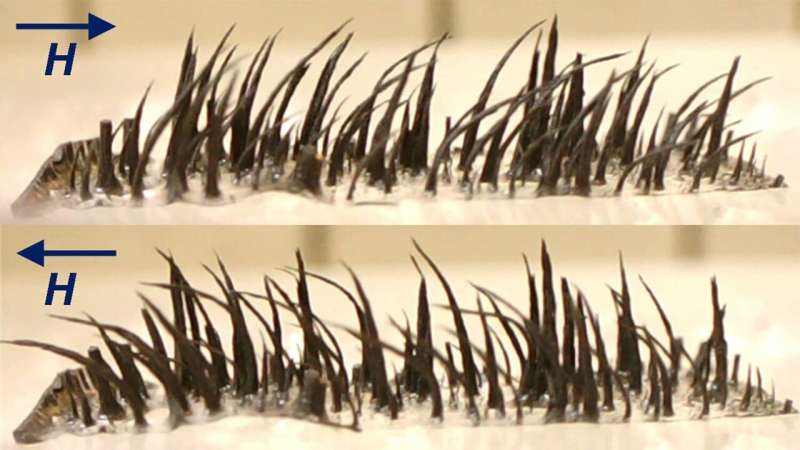The bends of NdFeB-based magnetic cilia magnetized in a horizontal magnetic field point upward. Image credit: Matthew R. Clary.
Magnetic ciliated artificial hair, whose motion is driven by embedded magnetic particles, has been around for some time, generating interest for applications in soft robotics, transporting objects, and mixing liquids. However, existing magnetic cilia move in a fixed manner.
Researchers have now demonstrated a technique to create “reprogrammable” magnetic cilia that can change their magnetism at room temperature, thereby altering the cilia’s movement as desired.
Most magnetic cilia utilize “soft” magnets, which do not generate a magnetic field but become magnetic in the presence of a magnetic field. Only a few magnetic cilia have previously used “hard” magnets capable of generating their own magnetic fields.
One of the advantages of using hard magnets is that they are programmable, meaning you can give the magnetic field produced by the material a specific polarization. Controlling magnetic polarization, or magnetization strength, allows you to determine essentially exactly how the cilia will bend when an external magnetic field is applied.
“What’s novel about this work is that we demonstrate a technique that not only programs magnetic cilia, but also controllably reprograms them,” said Joe Tracy, professor of materials science and engineering and corresponding author of the work. .
“We can change the direction of the material’s magnetization at room temperature, which in turn allows us to completely change the way the cilia bend. It’s like asking swimmers to change their stroke.”
In this work, the researchers created magnetic cilia composed of polymers embedded with magnetic particles. Specifically, these particles are neodymium magnets—powerful magnets made of neodymium, iron, and boron.The paper “Magnetic reprogramming of self-assembled hard magnetic cilia” was published in the journal Advanced Materials Technology.
To create cilia, the researchers introduced magnetic particles into a polymer dissolved in a liquid. The slurry is then exposed to an electromagnetic field strong enough so that all particles have the same magnetization.
Then, by applying a weaker magnetic field as the liquid polymer dries, the researchers were able to control the behavior of the particles to form regularly spaced cilia on the substrate.
“This carpet of regularly arranged cilia is originally programmed to behave in a uniform way when exposed to external magnetic fields,” Tracy said. “But what’s really interesting here is that we can reprogram this behavior so that the cilia can re- Repurposed to create a completely different drive.”
To do this, the researchers first embedded the cilia in ice, holding all of them in the desired orientation. The researchers then exposed the cilia to a damped alternating magnetic field, which has the effect of disrupting the magnetization of the particles. In other words, they essentially eliminate the preprogrammed magnetization that all particles share when making cilia.
“The reprogramming steps are pretty simple,” Tracy said. “We applied an oscillating field to reset the magnetization and then applied a strong magnetic field to the cilia, which allowed us to magnetize the particles in new directions.”
“By largely erasing the initial magnetization, we are better able to reprogram the particle’s magnetization,” said doctoral student Matt Clary, the paper’s first author. student at North Carolina State University. “We show in this work that if the erase step is omitted, there is less control over the direction of the particle’s magnetization upon reprogramming.”
“We also found that when the magnetization of the particles is perpendicular to the long axis of the cilia, we can make the cilia ‘get stuck’ in a rotating field, meaning they suddenly change direction,” Tracy said.
In addition, the research team developed a computational model that allows users to predict the bending behavior of hard magnet-based magnetic cilia based on the direction of cilia polarization.
“This model could be used to guide the design of hard magnetic cilia and related soft actuators in the future,” said Ben Evans, a co-author of the paper and a professor of physics at Elon University.
“Ultimately, we think this work will be valuable to the field because it allows magnetic cilia to be repurposed for new functions or applications, particularly in distal settings,” Tracy said. “The methods developed in this work could also be applied to the wider field of magnetic soft actuators.”
Co-authors of the paper are Saarah Cantu, a former graduate student at NC State; and Jessica Liu, a former PhD student at NC State.
More information:
Matthew R. Clary et al., Magnetic reprogramming of self-assembling hard magnetic cilia, Advanced Materials Technology (2024). DOI: 10.1002/admt.202302243
Offered by North Carolina State University
citation: Researchers show old magnetic cilia can be taught new tricks (2024, April 24) Retrieved April 24, 2024, from https://phys.org/news/2024-04-magic-cilia.html
This document is protected by copyright. No part may be reproduced without written permission except in the interests of fair dealing for private study or research purposes. Content is for reference only.
#Researchers #show #ancient #magnetic #cilia #taught #tricks
Image Source : phys.org
